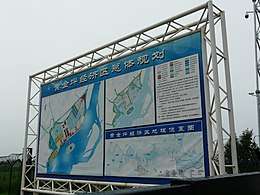Hwanggumpyong Island
Hwanggumpyong Island (Korean: 황금평, simplified Chinese: 黄金坪; traditional Chinese: 黃金坪; pinyin: Huángjīnpíng) is an island on the Yalu River, which forms a section of the land border between North Korea and China. The majority of the island belongs to North Korea, due to ethnic Koreans living on the island at the time of a 1962 border treaty. The island is an exclave on the otherwise Chinese side of the river.[1]
 | |
| Geography | |
|---|---|
| Location | Yalu River |
| Coordinates | 39.96°N 124.31°E |
| Administration | |
| County | Sindo County |
| Province | North P'yŏngan |
| Demographics | |
| Ethnic groups | Koreans |
History
In June 2011, an agreement, negotiated by Gao Jingde, of Sunbase International Holdings Ltd,[2] with China was made to establish a joint free trade area on Hwanggumpyong and Wihwa Islands, and the Chinese border area near Dandong.[3] By 2013 the site had been prepared, and free trade area of over 300 acres (120 ha) may be ready for operation in about two years.[4]
As of 2019, the free trade area has not been very successful.[5]
References
- Jeong Woo-sang (10 June 2011). "What Is Hwanggumpyong Island?". Digital Chosun. Retrieved 1 March 2012.
- Kim, Young-gyo (20 June 2011). "Hong Kong conglomerate likely to be tapped as developer of N. Korean island: report". Yonhap News Agency.
- Robert Kelley; Michael Zagurek; Bradley O. Babson (19 February 2012). "PRC's Embrace of North Korea: The Curious Case of the Hwanggumpyong Island Economic Zone". 38 North. U.S.-Korea Institute, Johns Hopkins University School of Advanced International Studies. Retrieved 1 March 2012.
- Nick Hansen; Jeffrey Lewis (17 June 2013). "New Construction Activity at the Hwanggumpyong Economic Zone". 38 North. U.S.-Korea Institute, Johns Hopkins University School of Advanced International Studies. Retrieved 22 June 2013.
- Clément, Théo (29 October 2019). "Failed Attempts at Cross-Border Economic Integration: The View from Dandong". 38 North. The Henry L. Stimson Center. Retrieved 8 November 2019.